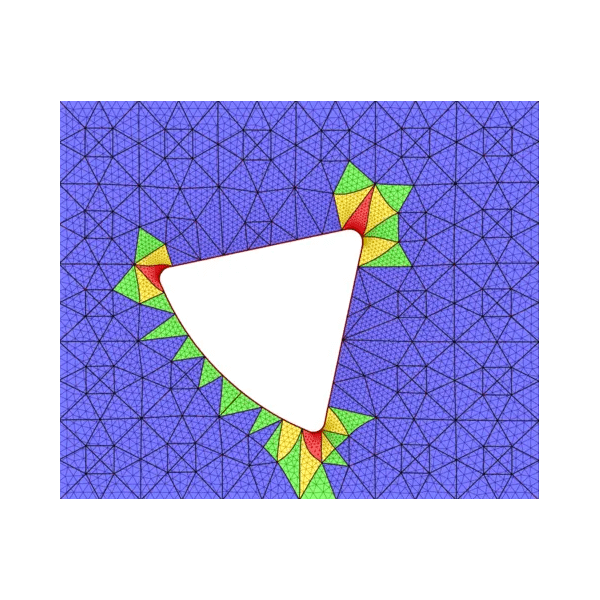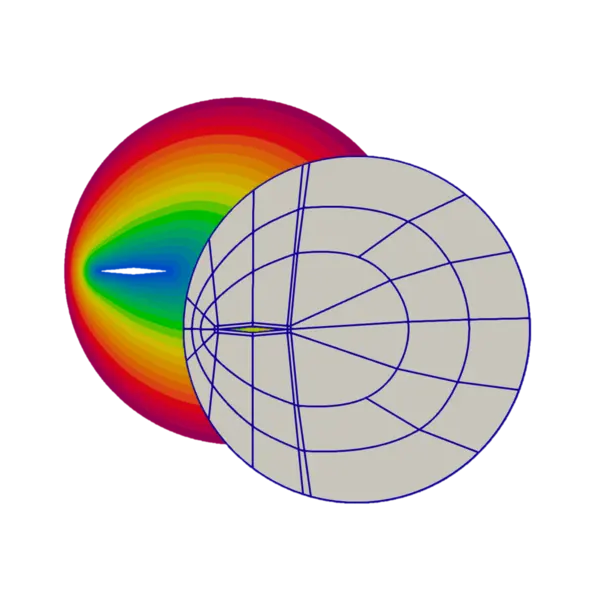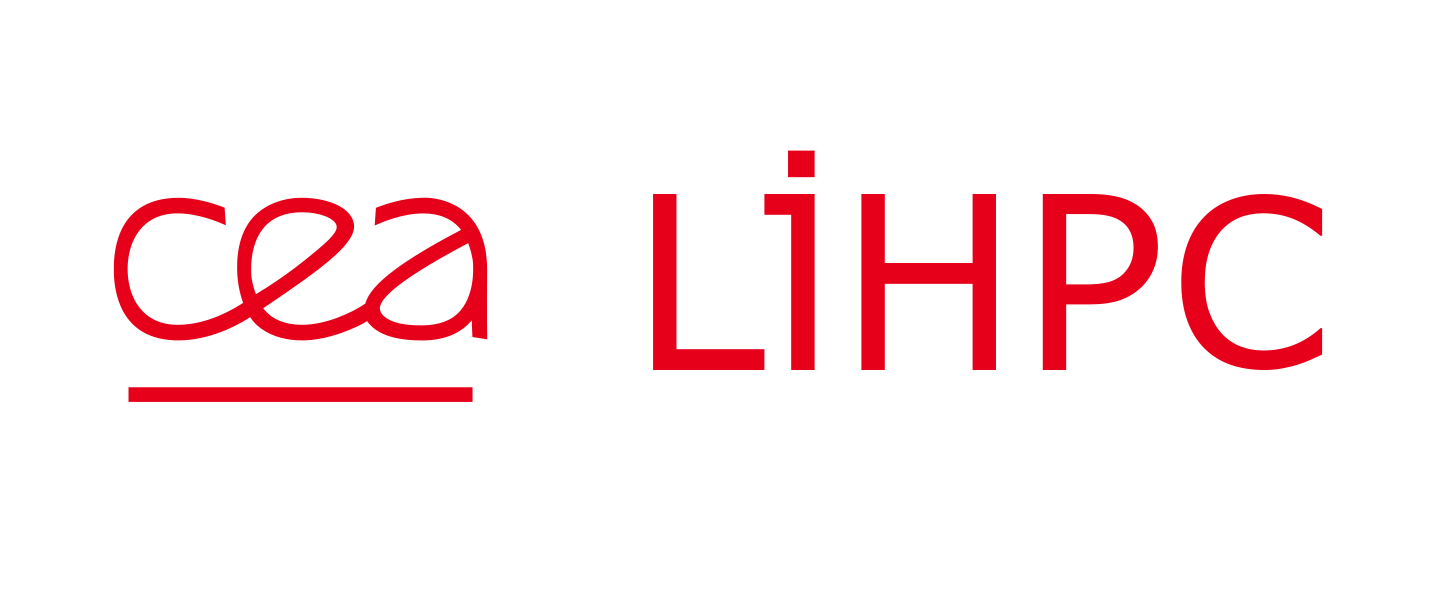Claire ROCHE was a Ph.D. student at CEA, supervised by Jérôme BREIL and Thierry HOCQUELLET. Her thesis director was Franck LEDOUX, an HDR Engineer Researcher at CEA.
Claire’s thesis topic was the following: “Automatic hexahedral mesh generation for atmospheric re-entry”. This thesis aims to provide a method to generate automatic hexahedral block-structured mesh dedicated to a Computational Fluid Dynamics code, developed for atmospheric re-entry. These simulations require a very strong control of cell size and direction. To our knowledge, these meshes are generated by hand with dedicated software and take a huge amount of time. In this work, under conditions on the physical domains, we develop an algorithm to generate these meshes most automatically.
This work is freely available and implemented in the open-source meshing framework GMDS.
2024

abstract
Abstract
This animation has been realized using ParaView [1] and aims to demonstrate the different steps of an algorithm developed to generate block-structured meshes suitable for Computational Fluid Dynamics simulations of flows around vehicles during atmospheric re-entry. This method takes a tetrahedral mesh of the domain as input and the quadrangular block discretization of the vehicle surface. A linear blocking is obtained using an advancing front algorithm. This means it is incrementally created from the vehicle surface, layer by layer. Some distance and vector fields are computed on the tetrahedral mesh to lead the block's extrusion direction. Then, the linear blocking is curved, and the final mesh is generated. The algorithm is freely available and implemented in the open-source C++ meshing framework GMDS [2,3]. The algorithm is based on the previous work of Ruiz-Gironés et al. [4,5]. Details of the algorithm are available in [6,7]. Here, the algorithm generates a mesh around a vehicle with two wings. This block structure is generated on four different layers. The creation of the first layer of blocks is shown here, block by block. [1] https://www.paraview.org/ [2] https://github.com/LIHPC- Computational- Geometry/gmds [3] Franck Ledoux, Jean-Claude Weill, and Yves Bertrand. Gmds: A generic mesh data structure. 17th International Meshing Roundtable, 2008. [4] Eloi Ruiz-Gironés. Automatic hexahedral meshing algorithms: from structured to unstructured meshes. PhD thesis, Universitat Politècnica de Catalunya (UPC), 2011. [5] Eloi Ruiz-Gironés, Xevi Roca, and Josep Sarrate. The receding front method applied to hexahedral mesh generation of exterior domains. Engineering with computers, 28(4):391–408, 2012. [6] Claire Roche, Jérôme Breil, Simon Calderan, Thierry Hocquellet, and Franck Ledoux. Curved hexahedral block structure generation by advancing front. In SIAM International Meshing Roundtable Workshop 2024 (SIAM IMR24), 2024. [7] Claire Roche, Jérôme Breil, Thierry Hocquellet, and Franck Ledoux. Block-structured quad meshing for supersonic flow simulations. In SIAM International Meshing Roundtable Workshop 2023 (SIAM IMR23), Amsterdam, The Netherlands, March 2023.
Proceedings of the 2024 International Meshing Roundtable (IMR), 2024

abstract

Abstract
Computational analysis with the finite element method requires geometrically accurate meshes. It is well known that high-order meshes can accurately capture curved surfaces with fewer degrees of freedom in comparison to low-order meshes. Existing techniques for high-order mesh generation typically output meshes with same polynomial order for all elements. However, high order elements away from curvilinear boundaries or interfaces increase the computational cost of the simulation without increasing geometric accuracy. In prior work [5, 21], we have presented one such approach for generating body-fitted uniform-order meshes that takes a given mesh and morphs it to align with the surface of interest prescribed as the zero isocontour of a level-set function. We extend this method to generate mixed-order meshes such that curved surfaces of the domain are discretized with high-order elements, while low-order elements are used elsewhere. Numerical experiments demonstrate the robustness of the approach and show that it can be used to generate mixed-order meshes that are much more efficient than high uniform-order meshes. The proposed approach is purely algebraic, and extends to different types of elements (quadrilaterals/triangles/tetrahedron/hexahedra) in two- and three-dimensions.
SIAM IMR24-SIAM International Meshing Roundtable Workshop, 2024

abstract
Abstract
This work aims to provide a method to generate block-structured meshes suitable for Computational Fluid Dynamics (CFD) simulations of flows around vehicles during atmospheric re-entry. This method takes as input a tetrahedral mesh of the domain, and the quadrangular block discretization of the vehicle surface. A linear blocking is obtained using an advancing front algorithm. This means it is incrementally created from the vehicle surface, layer by layer. Then, this linear blocking is curved, and we generate the final mesh. Some results of blocking and corresponding meshes generated with our algorithm are shown.
Thèse de Doctorat de l'Université Paris-Saclay, 2024

abstract
Abstract
Le Commissariat à l'Énergie Atomique et aux Énergies Alternatives (CEA) s'intéresse à la simulation d'écoulements fluides en régime supersonique et hypersonique dans le cadre de la rentrée atmosphérique. Pour ce faire, un code de simulation numérique dédié y est développé. Pour répondre à des contraintes fortes, ce code ne prend en entrée que des maillages hexaédriques structurés par blocs. Ce type de maillage est compliqué à générer, c'est le plus souvent réalisé à la main via l'utilisation de logiciels interactifs dédiés. Pour des géométries industrielles complexes, la génération d'un maillage est très couteuse en temps. A l'heure actuelle, la génération automatique de maillages hexaédriques est un sujet de recherche ouvert et complexe.Dans le cadre de ces travaux de thèse, nous proposons une méthode permettant de générer des maillages structurés par blocs courbes de domaines fluides autour de géométries dédiées pour les problématiques visées. Cette méthode a d'abord été prototypée dans le cadre de domaines 2D, puis étendue au cas 3D. Ici, la méthode est présentée dans le cas général, en dimension n. Elle se découpe en plusieurs étapes qui sont les suivantes.Dans un premier temps, une structure de blocs linéaire est obtenue par extrusion d'une première discrétisation de la paroi. Ces travaux sont une extension des travaux proposés par Ruiz-Girones et al.. Une fois cette structure de blocs linéaire obtenue, nous proposons deux manières distinctes de courber les blocs afin d'améliorer la représentation de la géométrie, et de limiter le lissage sur le maillage final. La première est à travers d'un processus de lissage de maillage à topologie fixe à l'aide d'un problème d'optimisation, auquel un terme de pénalité est ajouté pour aligner certaines arêtes du maillage aux interfaces. Dans notre processus, nous appliquons cette méthode de lissage à la structure de blocs pour l'aligner sur la surface du véhicule. Cette méthode étant pour l'instant trop couteuse en temps de calcul dans le cas 3D, nous proposons une seconde manière de courber les blocs, à travers une représentation à l'aide de courbes polynomiales de Béziers. Nous appliquons cette fois des opérations géométriques et locales afin d'aligner les blocs à la géométrie.Enfin, en partant du principe que les blocs sont représentés à l'aide de courbes de Bézier, nous générons un maillage final sur ces blocs courbes sous différentes contraintes. Finalement, nous évaluons la qualité des maillages générés à travers des critères purement géométriques, en étudiant l'impact des différents paramètres de notre méthode sur le maillage final. Nous évaluons également les maillages générés par la simulation d'écoulements fluides sur ces maillages, avec la comparaison à des données expérimentales, analytiques, ainsi qu'à des calculs de référence.
Abstract
Quad meshing is a very well-studied domain for many years. Although the problem can generally be considered solved, many approaches do not provide adequate inputs for Computational Fluid Dynamics (CFD) and, in our case, hypersonic flow simulations. Such simulations require very strong monitoring of cell size and direction. To our knowledge, engineers do this manually with the help of interactive software. In this work we propose an automatic algorithm to generate full quadrilateral block structured mesh for the purpose of hypersonic flow simulation. Using this approach we can handle some simulation input like the angle of attack and the boundary layer definition. We will present here 2D results of computation on a hypersonic vehicle using the meshes generated by our method.
International Meshing Roundtable, 2023


abstract

Abstract
Quad meshing is a very well-studied domain for many years. While the problem can be globally considered as solved, many approaches do not provide suitable inputs for Computational Fluid Dynamics (CFD) and in our case for supersonic flow simulations. Such simulations require a very strong control on the cell size and direction. To our knowledge, engineers ensure this control manually using interactive software. In this work we propose an automatic algorithm to generate full quadrilateral block structured mesh for the purpose of supersonic flow simulation. We handle some simulation input like the angle of attack and the boundary layer definition. Our approach generates adequate 2D meshes and is designed to be extensible in 3D.
Abstract
The ablation of a vehicle during atmospheric reentry leads to a degradation of its surface condition. Ablated wall interacts with the boundary layer that develops around the object. The deformation can be seen as a ripple or a roughness pattern with different characteristic amplitudes and wavelenghts. The effect of this defect on the flow is taken into account either by means of modelizations or by direct simulation by applying the strains to the mesh. Mesh adaptation techniques can be used in order to take into account wall deformations during a simulation. The principle is to start from an initially smooth mesh, to apply a strain law, then to use regularization and refinement methods. The meshes will be adapted for use in a parallel CFD Navier-Stokes code. A refinement of the mesh close to the wall is required to correctly capture the boundary layer [2], but also to accuratly represent the geometry of the wall deformation. For the numerical methods used, a constraint of orthogonality is added to the mesh impining on the wall. The developments are for the moments, carried out in an independent external tool. The regularization methods are compared on results of simulations with different meshes. The method can be easily coupled with a CFD code and can be extended to 3D geometries.






